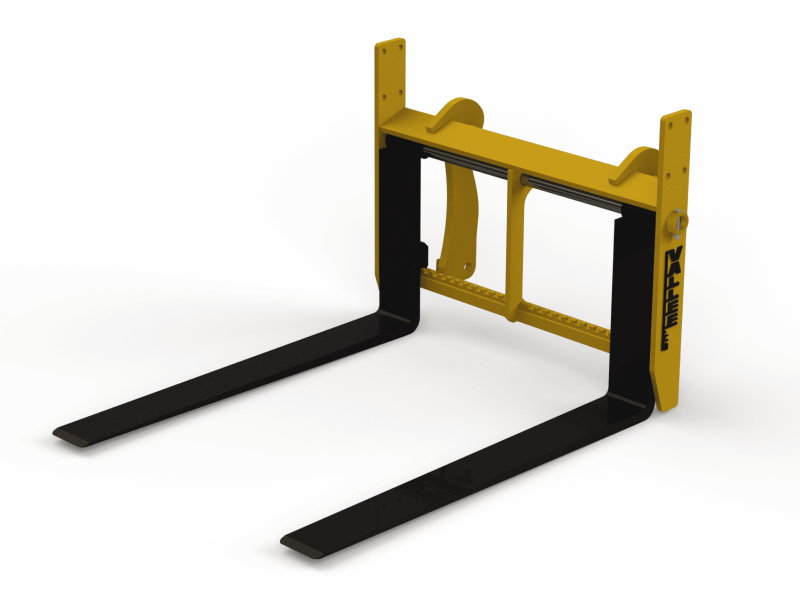Forks—the two parallel arms extending from the front of your forklift—are essential and inseparable components of the machine. Though they may seem simple, their role is fundamental: to lift, transport, and place loads safely. Using the right forks is crucial for the success of your material handling operations. Discover the different classes of forks, including ITA hook-type forks, and other available models for your forklift.
NOTE: ITA is a North American standard that defines how forks are mounted onto a forklift. An ITA fork (also known as a “hook-type” fork) attaches easily to the forklift carriage without the need for bolts, simplifying installation, replacement, and ensuring compatibility with most forklift models. It is now the most widely used standard in industrial environments.
3 Key Features of ITA Hook-Type Forks

ITA hook-type forks, defined by the Industrial Truck Association, are the most common fork types used in the material handling industry. Their clever design allows for interchangeability between forklifts, provided the carriage class is the same.
1- What you should know about ITA hook-type forks:
- They are also called clip-on forks.
- Simplicity: Hooks at the top and bottom of the fork latch onto the bars of your forklift’s carriage.
- Known for their durability, strength, and versatility, they are essential for transporting and stacking palletized goods in warehouses, distribution centers, and factories.
- They are compatible with a wide range of lifting vehicles, including small forklifts, high-capacity trucks, telehandlers, and even wheel loaders.
2- Thickness, Width, and Length: Dimensions of ITA Hook-Type Forks
Fork dimensions are usually expressed in the order Thickness x Width x Length. A standard fork size, for example, is 1 ½” x 4″ x 42″.
Fork Thickness:
- Measured along the heel or the vertical part of the fork, also called the back or shank.
- The most common thickness is 1 ½ inches, but other standard sizes include 1 ¾”, 2″, and 2 ½”.
- The thickness depends directly on the forklift’s lifting capacity and the weight of the loads being lifted.
- To lift heavier weights with limited fork width, increasing the thickness may be required.
Fork Width:
- Measured across the face of the blade or heel.
- Standard width for Class II forks is generally 4 inches.
- For Classes III and IV, typical widths are 5 and 6 inches, respectively.
- Some applications require wider or narrower forks; for example, telehandlers may use forks that are 4, 5, 6, or even 7 inches wide.
Fork Length:
- Measured from the tip of the fork to the front face of the heel.
- A standard 42-inch fork length is common for Classes 2 and 3, as it fits standard-size pallets without extending beyond the rear.
- Forks should extend at least two-thirds the length of the load to ensure stability and safety. Forks that are too short or too long can damage the load, the equipment, or even injure personnel.
3- ITA Hook-Type Fork Classes
Forks are categorized according to the ITA carriage class, which corresponds to a standardized height between the top and bottom bars of the forklift’s carriage. There are 5 ITA carriage classes. Each class is associated with a maximum lifting capacity that both the forklift and forks can support. Your forks must match your forklift’s rated capacity.
A forklift carriage example

ITA Classes and Their Capacities:
- Class 1: Carriage height 13 inches, Capacity < 2,200 lb
- Class 2: Carriage height 16 inches, Capacity 2,200 to 5,500 lb
- Class 3: Carriage height 20 inches, Capacity 5,500 to 10,998 lb
- Class 4: Carriage height 25 inches, Capacity 11,000 to 17,600 lb
- Class 5: Carriage height 28.66 inches, Capacity 17,602 to 24,198 lb
Hook-Type Forks
Although ITA forks are often referred to as hook-type forks, other generic hook-type fork models differ in design. These accessories feature a unique hook mechanism at the end of each fork, ensuring secure attachment to various types of loads.

Non-ITA Hook-Type Forks
- Their innovative design provides greater load stability by minimizing the risk of shifting or slipping.
- They offer excellent versatility, easily adapting to various load shapes and sizes, potentially reducing the need for multiple attachments.
- They are quick to change, saving operators valuable time.
Shaft-Mounted Forks
These forks are mounted to the forklift using a shaft. Installation involves sliding the forks onto an axle that runs the full width of the forklift’s carriage.

- Renowned for their durability and versatility, they can support heavy loads and suit a wide range of applications.
- Commonly found on older or high-capacity forklifts, and equipment equipped with fork positioners, compact loaders, and telehandlers.
- They can be custom-made to meet specific requirements.
Bolt-On Forks
Bolt-on forks are characterized by their attachment method, which involves securing or removing them using bolts. They feature a flat plate with pre-drilled holes that align with those on the forklift.

- Their main advantage lies in flexibility. Bolting mounting reduces carriage flex, improving stability and safety.
- They are remarkably stable during all types of movement thanks to their secure attachment.
Rotator Forks
Rotator forks are accessories that can rotate or pivot independently of the forklift mast, usually up to 180 degrees or more. They are also known as rotating or side-shift forks.

- They are mounted on a rotator attachment that allows the forks to tilt or flip, enabling them to empty loads into other containers.
- They offer increased precision and control, reducing the risk of product or infrastructure damage while boosting efficiency and productivity.
- Their versatility makes them valuable in a wide range of industries, including manufacturing, distribution, and warehousing.
Conclusion
Choosing the right forklift forks is a strategic decision that directly impacts the safety of your operations, the efficiency of your material handling, and the longevity of your equipment. Well-chosen forks reduce accident risks and enhance productivity. For guidance and to explore how our solutions can improve your safety and performance, contact the specialized manufacturer Vallée today.



